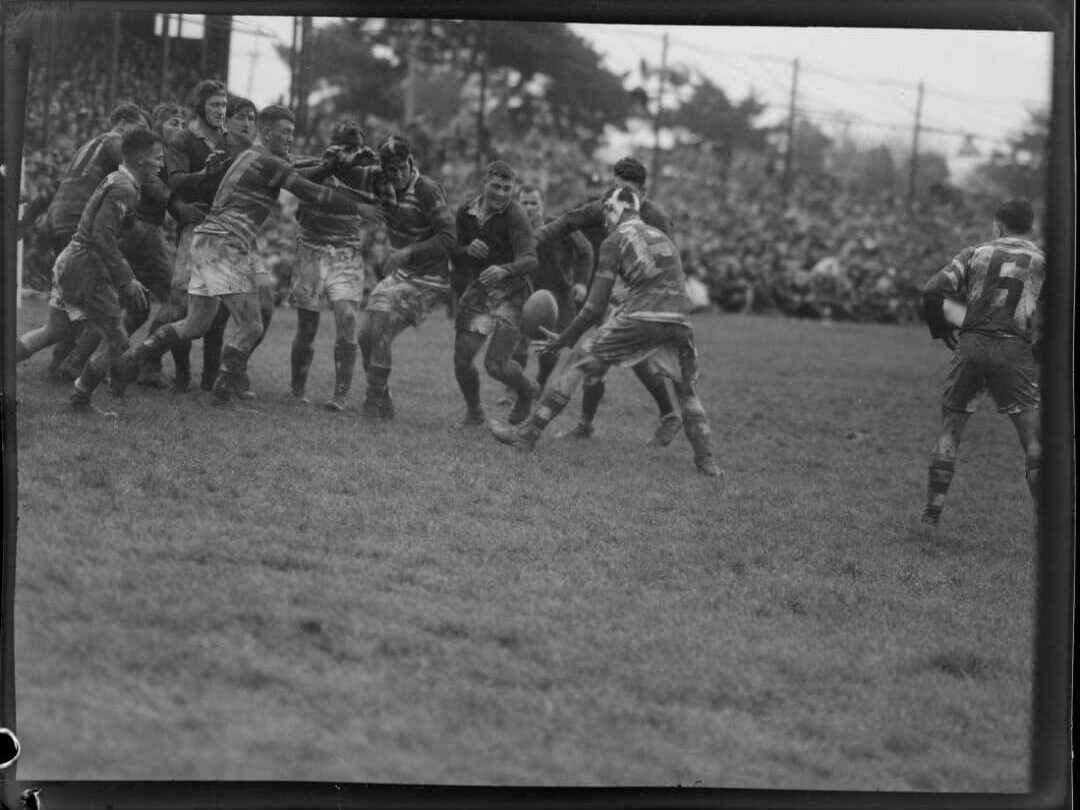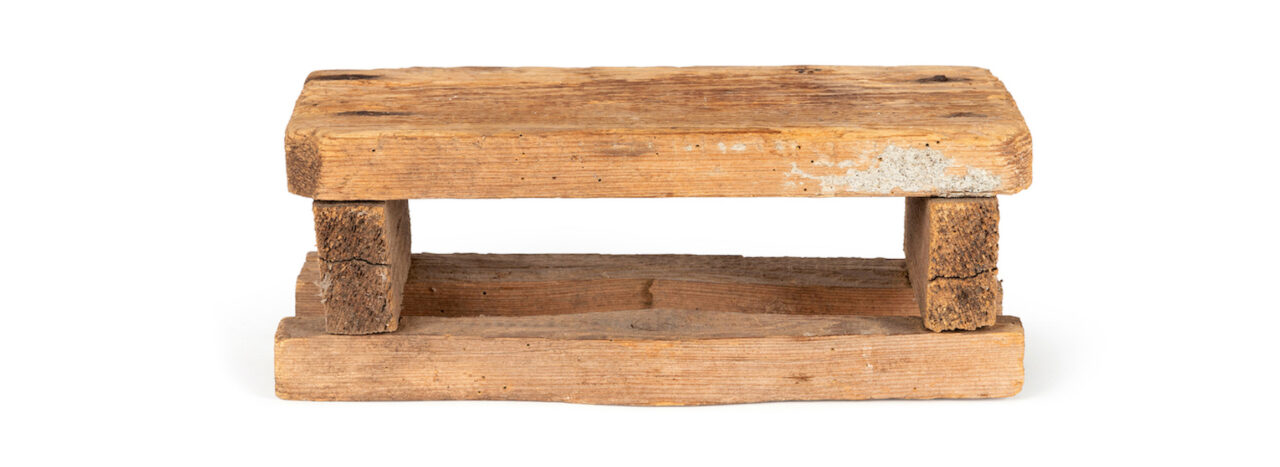Rugby seat, 1956, donated by Richard Mildon, Te Manawa Museums Trust, 2021/50/1.
On Wednesday 20 June, 1956, when the Springboks were touring New Zealand, they played the Manawatu-Horowhenua team in Palmerston North. Boys from the surrounding schools were invited to watch the game. Because we would be sitting on the grass just outside the area of the playing field we were allowed to bring a seat with us to keep our backsides dry. The seat was not allowed to be more than four inches high.
I was at Kairanga School, in Standard 3. Dad and I put together a seat made from pieces of wood cut to length with a saw and other pieces split off with an axe. The bits were nailed together. It was about 4 inches (10 centimetres) high. To provide a bit of comfort I cut a bit off a Dunlopillo mattress and glued it to the seat. It was now about eight inches high, but it squashed down to about 4 inches and was a bit comfier than a hard board. When we gathered at the school, to be allocated a parent’s car to be driven to the match in, I saw that most of the boys had only brought a piece of flat board as a seat, so I got a bit of a ribbing.
We drove into the show grounds at the entrance on the south side of the old main stand. We then walked around the south side of the field in front of other schoolboys who had already arrived. As we walked behind the goal posts at that end, a voice yelled out from the crowd of boys ‘Look at the height of his seat!’
We kept on walking around until we got to our allocated spot about midway between the corner of the field and what was known then as the ‘old’ grandstand, our school occupying about six to eight yards of frontage just a few feet from the sideline. On the south side of us were the boys from Te Arakura School.
The match started and progressed with the usual yelling and shouting. I must admit, though, that I only remember one moment clearly of the whole game. That was when the ball came free in our direction closely followed by players from both sides. By the time the ball had reached near the sideline possession was being hotly contested by at least half a dozen players, and their impetus was such that a whole bunch of players crashed in a jumble tussling for the ball over the sideline into the Te Arakura boys. There was the most awful, juicy, ‘thunking’ sound of a boot connecting with something hardish. The players cleared themselves out of the melee for the lineout. Amongst the Te Arakura boys there was some fuss, but most noticeable was one of them making more fuss than the others. He had an egg-sized bump on his forehead which was the result of the sickening thump with a boot.
Anyway, the game continued, we lost, and then all went home, having had an afternoon off school.

Springboks versus Manawatu-Horowhenua at Palmerston North. Evening post (Newspaper. 1865-2002) :Photographic negatives and prints of the Evening Post newspaper. Ref: EP/1956/2033to2100-07b-F. Alexander Turnbull Library, Wellington, New Zealand. /records/23211701
In 1957, the Fijian Ruby team toured New Zealand and played at Palmerston North on a Saturday (3 August); so it wasn’t a day off school, but the seat once again did good service. We sat at a different location nearer the old grandstand.
The following year, 1958, it was Manawatū playing against Australia on Wednesday 10 September. The schoolboys assembled with their portable seats in the same place as they had for the Springbok match in 1956. Kairanga School was sitting with Te Arakura once again alongside us.
The match started and all the usual noises were made. And at one point a player kicked the ball very high and towards the sideline in front of us. All eyes turned skywards. Watching the arc of its flight and estimating where it would land, I looked towards the spot where it might come down and it was clear it was going to land amongst the boys. I noticed that all the Te Arakura boys were following the flight of the ball except for one. He was looking around left and right as if he was completely unsighted as to where the ball was. He didn’t have long to wait. The ball landed fair and square on top of his head. The funny thing was, I recognised it was the same boy who had been kicked in the head during the Springbok match two years before.
The match against the Lions the following year on Tuesday 11 August saw the seat used again. So far as the boys’ physical engagement with the players or the ball, the game was very dull. The standout features of the game were the very short, white shorts and low-cut, lightweight boots the Lions played in which seemed to lend wings to their feet, compared to the plodding, high, ankle-protecting, square-nosed boots still being worn by New Zealanders. Of course, the standout player was Tony O’Reilly who seemed to epitomise a new character in the game of speed rather than slog, and of agility rather than lumbering about a soggy pitch.
That is the story of a seat that earned its keep over four years. The sponge rubber is long gone and borer have made some incursions, but the memories remain.
The funny thing is I hated rugby. When playing I always tried to be as far away from the ball as possible. There was no joy flogging around a sodden pitch at a place like Kimbolton, where the wind was icy cold and it was all but snowing. But kick a ‘footie’ I could. By Standard 6 (1959) I could plonk a ‘placie’ over the bar from nearly the 10 yard mark off my big toe and do a ‘droppie’ the same. And all in bare feet. Boots were a drag. At high school I elected to play soccer.




